Mad Max drove the last of the V8 Interceptors. This may be your last chance to drive the last V6 powered crossover.
Which also happens to be the first crossover.
The Lexus RX.
What It Is
Way back in 1998, Lexus introduced the RX300. It was a big introduction – because back in ’98, there weren’t any other luxury crossover SUVs.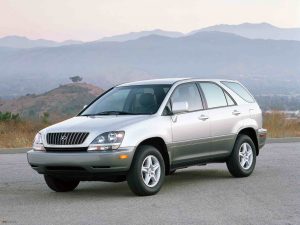
It was the first of its kind, an entirely new kind of vehicle. A vehicle that was neither a car nor an SUV but blended elements of both. It was based on a car – the Camry – but rode higher off the ground, like a truck-based SUV. But it still handled and drove like the car it was based on while also being nearly as capable of dealing with a snowstorm as a truck-based SUV.
Without handling and driving like one.
People really liked the concept and bought RXs like people used to eat Pez. Others imitated the concept to such a degree that now every car company – not just luxury car companies – not only sells crossovers, many sell only crossovers.
But the RX – currently the RX350 – remains the Long Legged Mack Daddy, the Original Gangster of crossovers.
It is also one of the few new crossovers that still comes standard with a V6 and no turbo – which is one of the things that makes it stand out in a field now crowded with similar crossovers that come standard with heavily turbocharged four cylinder engines to make up for the lack of cylinders.
It also comes in two version, two or three rows – as opposed to rivals like the Acura MDX, which also comes standard with a V6, but comes only one way – with three rows you may not need or want to pay a couple thousand additional for.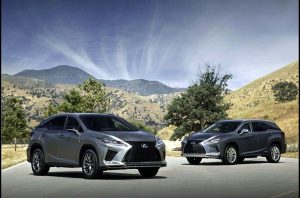
Prices start at $45,320 for the two-row RX350 with the V6 and FWD; adding AWD bumps the MSRP to $46,720.
An F-Sport version is available.
It features firmer suspension tuning as well as interior and exterior trim ugrades inspired by the Lexus LF-A supercar. It stickers for $48,800 to start with FWD and $50,200 with AWD.
The three-row Lexus RX350L stickers for $48,150 to start; $49,550 with the optional AWD system. Lexus does not offer an F-Sport variant of the three-row RX but there is a more opulent Luxury version that stickers for $54,100 with FWD and $55,550 with AWD.
What’s New
2022 is a carryover year, with only a few slight changes from last year – including the availability of fog lights on all trims (not just the F-Sport).
It may also be the final year.
For the V6.
It’s probable that the RX will be completely updated for the 2023 model year and that update may include a new turbocharged four cylinder or partially-electric (hybrid) drivetrain, as Lexus strains to keep up with the pressure to comply with government regulations that are making it very difficult for any car company to continue building V6 engines – or even just engines, without electric motors connected to them.
What’s Good
Two – or three – rows. Pick what you need. Don’t pay more for what you don’t.
The RX’s 3.5 liter V6 is the Swiss Franc of engines. It has perhaps the longest and best track record for durability and reliability, going back decades.
F-Sport looks serious.
What’s Not So Good
Console-mounted trackpad controller is awkward to use, especially while in motion.
F-Sport is mostly just looks. It does not get more power to match its mien.
This may be the last V6 RX.
All versions of the RX, both two and three row – as well as F-Sport and not – come with the same 3.5 liter, 295 horsepower V6, paired with an eight speed automatic.
Ten – even five years ago – this drivetrain would have been as unremarkable as tires being black. Fast forward to now and it is exceptional. The federal government – via its fuel economy and “emissions” regulations, the latter redefined to include carbon dioxide – an “emission” that has nothing to do with air pollution, as emissions were once understood to be defined by – have made it very difficult to offer engines larger than four cylinders and about 2.0 liters, heavily boosted by turbochargers to get them to produce the power of a V6 but without using (or “emitting”) as much gas.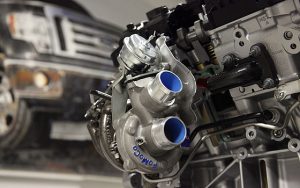
Toyota – which is Lexus – has stood fast against this trend, especially as regards turbos. Probably because Toyota has always been a very conservative car company as regards its engineering – and this is a very good thing, if you esteem long-term durability. It is not a coincidence that Toyota’s engines are known to last longer than other car companies’ engines – and ask less of you during the course of their long lives.
Toyota tends to not fix what isn’t broken.
The 3.5 liter V6 used in the RX is the same basic V6 used in the Toyota Camry and Avalon sedans as well as the Lexus ES350 sedan (which all share a common platform with each other and the RX). It is the long-beating heart of these notoriously long-lived, superbly reliable sedans – and it’s the reason for the RX’s earned reputation for being as close to immortal as a vehicle ever has come. Original RXs from the late ‘90s and early 2000s are still a common sight on the road, even though these are now pushing – or have pushed past – 20 years old.
The brilliant conservatism of Lexus also manifests in what’s attached to the V6, which is not a continuously variable (CVT) automatic or an automatic with ten speeds (as in the Acura MDX). CVTs and ten speeds are in so many vehicles today for the same reason that V6s are no longer in them. The CVT’s lack of gears – it transitions through ranges – achieves a slight fuel economy benefit (on the order of 2-3 MPG) as does having three overdrive gears, as in the ten speed automatics that increasingly abound.
But a CVT tends to make the drivetrain feel mushy.
Mashing the accelerator is like depressing the throttle of a chainsaw – and sometimes, sounds similar. The engine just revs – sometimes, right up to redline. And stays there, until you back off the throttle. A vehicle with a CVT transmission can feel like a vehicle with a failing transmission. Plus, CVTs are known to be less long-term durable and when they fail, they aren’t fixable. The band within snaps, leaving shrapnel scattered inside the case – rendering rebuilding not possible or rather, not worth the trouble.
You chuck it – and replace it.
The problem with ten speed automatics is that with so many gears, the transmission is constantly shifting and because of the spread between all those gears, there is often a noticeable lag in between all those shifts – as the computer decides which gear is needed and then sends the command to go from 10th or 9th to sixth or fifth. Plus, a ten speed is a more complicated piece of equipment than an eight speed transmission and it’s a kind of axiom of engineering that the more parts – the more complexity – the greater the odds of something eventually going wrong.
So if you prefer your engines powerful – and reliable – Lexus has you covered. Same goes for the transmission. Which – by the way – is engaged using a gear selector, not buttons or mouses.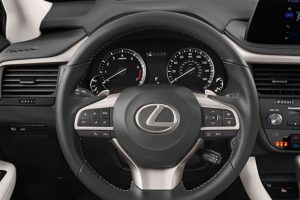
Lexus also lets you pick whether to go FWD or AWD, even if you want the racier-looking (and firmer-riding) F-Sport variant. The RX’s chief rival, Acura’s MDX, bundles its SH-AWD system with the top trim versions of this crossover – and charges extra, accordingly.
$57,400 to be precise. As opposed to $48,800 for the FWD version of the top-of-the-line RX350 F-Sport.
Zero to 60 happens in about 6.8 seconds for the FWD version of the F-Sport; adding AWD will cost a few tenths due to the additional weight of the AWD system, but the difference isn’t seat-of-the-pants noticeable.
Also not noticeable is the fuel economy difference between the V6 RX and some of the newer, turbo-four-powered competition.
The V6 RX rates 19 city, 26 highway – with or without AWD.
A Genesis GV80 with a turbocharged 2.5 liter four cylinder engine that produces roughly the same power (300) as the RX’s V6 rates 21 city, 25 highway – a difference without much distinction. A Lincoln Nautilus equipped with a 2.0 liter turbocharged four cylinder engine (and just 250 hp) rates 21 city, 26 highway – a difference with even less distinction.
And in real-world driving, these heavily turbocharged engines may not prove to be even that “efficient” – since in order to belt out those numbers, you have to keep light pressure on the accelerator, so as to not summon the boost of the turbocharger.If you do summon it, more fuel will be used.
This is the sad irony of the current government-forced fad of replacing V6 engines without need of turbos with four cylinder engines that do need them.
You are sold “better gas mileage,” which isn’t much and you probably won’t get it, anyhow. And you pay more to get it – up front as well down the road, when the time comes to replace a worn out turbo or an engine worn out from all that turbocharging.
On The Road
It is possible to get a four to deliver the power of a V6 engine – and more torque, sooner – via turbocharging. But it is impossible to get a four to feel – or sound – like a V6.
There is something deflating about the sound of a four in a vehicle with a $50k price. It is why some of the vehicles in this price range that have these little turbocharged fours have sound augmentation devices to make them sound better.
The tragic thing is, these turbo four-powered vehicles could sound better – without augmentation – if the car companies wouldn’t put so much effort toward muting the sound of the turbo. The whistle – and wastegate snap -one used to get to hear when there was a turbocharged engine under the hood has been muffled to near-silence, leaving the tinny treble sound of the little engine, as it struggles to move a big vehicle.
The RX doesn’t need augmentation. And its non-CVT transmission has the right feel – without the delay of a ten speed automatic trying to decide which gear to shift down or up to.
The F-Sport handles better than the standard RX and feels sportier – due to its more aggressive wheel/tire package and its available adaptive suspension system. But it could use another 30 horsepower to match its image.
At The Curb
The RX’s pioneering look – its overall silhouette – is no longer remarkable, because everyone else has copied it.
Lexus achieves differentiation today by offering something . . . different.
Two – or three – rows.
You can pick which suits and not pay extra for what doesn’t – or pay in the form of extra size and length you don’t need to get what you might want. As for example, the V6 engine that the RX’s main rival, the Acura MDX still comes standard with but which also comes standard with a third row and 198.4 inches of MDX – vs. 192.5 inches of RX.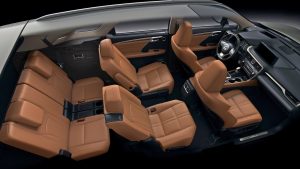
Or, you can get the RX-L and get that third row.
The point here is that you’ve got a choice – within the same model. Others give you no choice – or make you choose between different models within the make to get what you want. In the case of Acura, for example, if you want something with two rows that’s not as long – that’s still an Acura – your only option is the RDX, which is not an MDX – and doesn’t come standard with a V6.
If you choose the standard/two-row RX350 you will get two very roomy rows – 44.1 inches of legroom for the driver and front seat passenger and 38 inches in the second row. If you choose the longer (196.9 inches) RX350 L, you will get an additional row – and 58.5 total cubic feet of cargo capacity (vs. 32.7 for the standard/two-row RX).
The MDX has significantly more total standard cargo capacity (95 cubic feet) than either version of the RX but not everyone needs that – or the standard third row.
Lexus also includes a CD slot – and good luck finding that elsewhere, these days. There is also a handy upright snuggy for your smartphone.
One thing you can’t get is more performance. At least, not by checking off an option for more. Which isn’t there. The racy-looking F-Sport comes with the same drivetrain as the regular RX, so it’s not any stronger or faster, even though it looks like it might be. On the other hand, the F-Sport’s racy looks may be enough to justify its higher price and you do get firmer suspension tuning and 20 inch wheels, which up the handling ante.
The Rest
Like all luxury crossovers, the RX is . . . luxurious. It comes standard with leather trim, rain-sensing wipers and climate control AC.
You can get a panorama glass sunroof, heated and cooled seats and a great 12 speaker stereo, too.
However, many non-luxury-branded crossovers also come standard with such things, or offer many of them. What sets the RX apart from them is that it still comes standard with a V6 – while all of the lesser-branded crossovers now come with turbocharged fours.
The RX’s main weakness looks great.
It lies voluptuously on the center console. This is where you will see the ergonomically shaped wrist-rest that holds your right hand in just the right attitude to run your index finger along the trackpad that is just below it and which you use to tap what you want to access/engage from the roster of options displayed on the 12.3 inch LCD touchscreen. It is beautifully designed – but functionally, leaves much to be desired.
It is hard to mouse while you’re moving, first of all. And second of all, the system assumes you’re right handed. Lefties will find it even more awkward to use.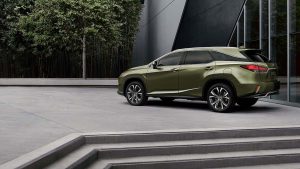
The good news is that Lexus built in manual redundancies. For example, you can still adjust the volume and change the station by hand – using rotary knobs. So you can appreciate the elegance and beauty of the ergonomic hand rest without having to actually try to use it.
The Bottom Line
Size really does matter – under the hood.
If you want to drive something out of the ordinary, today.
. . .
Got a question about cars, Libertarian politics – or anything else? Click on the “ask Eric” link and send ’em in! Or email me at EPeters952@yahoo.com if the @!** “ask Eric” button doesn’t work!
If you like what you’ve found here please consider supporting EPautos.
We depend on you to keep the wheels turning!
Our donate button is here.
If you prefer not to use PayPal, our mailing address is:
EPautos
721 Hummingbird Lane SE
Copper Hill, VA 24079
PS: Get an EPautos magnet or sticker or coaster in return for a $20 or more one-time donation or a $10 or more monthly recurring donation. (Please be sure to tell us you want a magnet or sticker or coaster – and also, provide an address, so we know where to mail the thing!)
My eBook about car buying (new and used) is also available for your favorite price – free! Click here. If that fails, email me at EPeters952@yahoo.com and I will send you a copy directly!


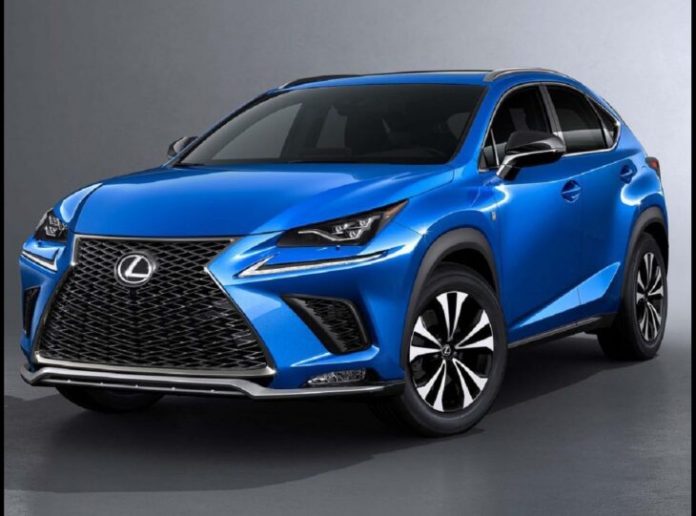

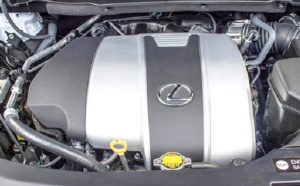
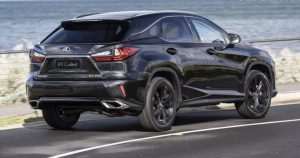









‘Size really does matter – under the hood.’ — eric
The top two photos — 2022 vs 1998 — highlight some revealing changes.
Most obviously, the 2022 RX350 seems to have taken a styling cue from pickups, with its noticeably elevated belt line and hood level. This thick-bodied look is accentuated by the cow-catcher (better to say, curb– catcher) bottom edge of the front clip, and tall, gape-mouthed black grille.
The 1998’s vestigial station wagon roof projection over the cargo area, with rear quarter windows, has disappeared. The 2022 glasshouse now has a smushed-down look like a Chrysler 300.
Conceding that aesthetics are a matter of personal taste, I’d say the 1998 version merely looks a little staid; a little bit gently dated.
But how will that 2022 model, with its aggressive, cartoonish styling tics, be perceived a quarter century from now?
Maybe a bit like we view cars of the mid-1970s, with their absurdly formal center grilles seemingly modeled on the Marriner S Eccles Building of the Federal Reserve. Nothing wrong with classicism, except when it’s crudely grafted onto a body that’s anything but.
At the risk of sounding curmudgeonly, one can observe that the degradation of IC engine options is being mirrored by increasingly jagged, incoherent styling cues — almost like a corporate cry for help from clay-flecked hostages in the design studio.
Maybe next year’s model, with the turbocharged four, will feature actual fangs in the widemouth hippo grille. Or a rounded codpiece to break up that vast black expanse. Yes, a distinctly modest-sized four needs an assertive codpiece to avert ego destruction for itself and its owner.
My wife just bought a 2018 RX350, extremely low mileage. It doesn’t have the mousepad, but two rotary nobs. One for the screen, one for sport/regular/economy modes.
It’s good sized. Bigger than the original by far. And it’s, by far, the most pleasant vehicle I’ve ever driven. Plenty of power, quiet as a library when cruising. She bought it for the same price as a 2019 Highlander. And it came with 3 years left on its bumper-bumper warranty, and 2 years on total maintenance.
What it didn’t come with is insurance for the high tech windshield. That had to be purchased.
I think I’m done buying anything but Toyotas anymore. They are so far ahead on design, build quality, and reliability it’s not funny.
I bought my 2013 RX 350 Oct ‘20. $19.9k ,,,39k miles. Inadvertently, extremely great timing (before the big price jumps and chip shortages). Stunning driver. Hope it lasts me a long time! Not giant fan of some of these new turbo “sewing machine” Four cyl’s
Hi Sara,
Your timing was excellent! And I think you’ll be happy with the RX. My sister is still driving the one my mom bought back in ’99. They are as reliable as a Camry. Which they should be, since the two are very closely related.
Still a huge fan of the RX350, still great for the day to day and weekend road trips, but definitely not one to use off road of course, would be a waste in this aspect imo.
They just don’t build SUV’s like they did before back in the day.
The size (and weight) of these vehicles is just too big for a 4, even with the turbo. When these vehicles age, they won’t age well. But I guess that is the point, the psychos in charge will want these off the road in ten years or less anyway. So they make it so they have to be. They can’t let us keep our gas vehicles even with tiny little engines.
Can’t imagine paying 50k for a vehicle with just a 4. It just doesn’t seem like a luxurious or even high end vehicle when you get the same thing in a economy car. Used to be 50k you were looking at optional engines BIGGER than a V8. It wasn’t that long ago V10s were pretty common in new pickups and big suvs.
I still would rather have a V8 charger than any “luxury” vehicle made today. At least at 50k I have a Hemi under the hood. That is the right size for that car.
RichB,
There’s UN Agenda 2030; the whole point is to get us in to the cities without our cars, living in micro apartments, so they can watch us 24/7/365. TPTB can’t let us have cars; they offer FREEDOM, man! We can’ thave that now! BTW, 2030 is a little more than 8 years away…
Eric,
Why do the luxury car companies HAVE to use turbocharged fours? If their mileage is below CAFE standards, doeosn’t that just mean a “gas guzzler” tax, which is passed on to the buyer? As your recent article pointed out, one of the former perks of luxury car ownership was getting engines that were exclusive, e.g. V12s. A luxury car buyer doesn’t mind spending extra for the exclusivity, so why not let ’em pay for it if they want V6es or V8s?
All turbocharging or supercharging does is pack a more dense fuel/air charge; in effect, it increases the displacement of a smaller engine. If it does that; and if the turbo is often running; then isn’t the smaller engine going to use as much fuel as its normally aspirated counterpart? I don’t get it. If I could afford a luxury car, I’d WANT a V8 or V12, damn it! If I wanted a 2.0 liter four, I can get that in anything and everything these days.
Long Legged Mack Daddy. LOL. That was a fun ten minutes figuring out what that means.
A guess: the Lexus RX350 employs auto stop/start and direct injection – possibly diminishing its reliability.
Also: “Console-mounted trackpad controller is awkward to use, especially while in motion.” Ties into your previous article “What Are Luxury Cars Selling These Days?” – to differentiate, making controls “pretty” rather than useful.
I own three vehicles, all 2012’s, two of them RAV4 V6 (3.5L) 4WD – no plans of experiencing a new vehicle.
The more I read your reviews, the more depressed I get about the prospect of ever having to buy a new car in the future.
They are definitely going to be less interesting. And less of a car.
If this is the last decent thing Lexus is going to do, it is a nice one.
Why would you buy new if there is nothing that fits the bill for you?
Especially if they are expensive. Since it’s going to be expensive, I think rebuilding of existing daily driver cars may become more of a business in the future. Well until uncle shuts that down too. It’s already a business for a few companies rebuilding the big SUVs and pickups into 6 or 8 door versions.
We shouldn’t buy new vehicles if they don’t build what we want. It will send a message to the automakers (who will run to uncle for a handout no doubt). It may be the only way we can send a message though.